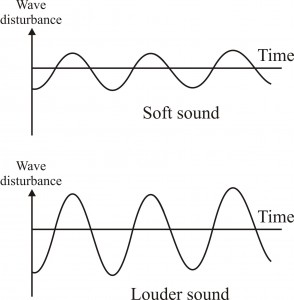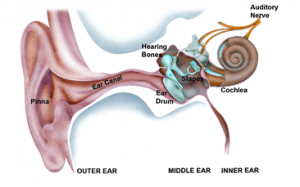Sound…
Since this series of articles is all about noise (sound) reduction, we thought that it might be useful to give you some background on what it is and how it “works”.
Sound is a form of energy that is created when air is disturbed such that the air pressure changes and radiates from the source of the sound in waves.
These sound waves vibrate at different frequencies, and are measured in cycles per second (Hertz). The faster that a sound wave travels past a given point, the shorter is its wavelength and the higher is its frequency. The “loudness” of the sound – which is a relative not absolute term and which is also impacted by other sounds – is caused by vibrations in the medium through which the sound is travelling (typically, in our experience, air); the stronger the vibrations, the greater the amplitude. Here’s a simple diagram to make things clearer:

How does the ear work?
The outer part of the ear (called the pinna, see the diagram below) channels sound travelling in the air directly into the ear canal towards the ear drum. Some higher pitched sounds are actually enhanced by the shape of the ear canal as they reach the ear drum. Sound is transformed into mechanical vibration at the ear drum.
The eardrum is attached to a chain of three hearing bones that act as a lever enhancing sounds while transferring the signal through the middle ear to the inner ear. The last of these middle ear bones (the stapes), is attached to the oval window, a thin tissue covering and entry point to the fluid-filled inner ear known as the cochlea.
The cochlea is a snail-shaped tube within the skull that contains sensory hearing cells. These sensory cells are situated on a flexible membrane tissue – the basilar membrane. When the oval window vibrates the basilar membrane and sensory hearing cells are displaced.
Two of the important sensory hearing cells are the outer hair cells and the inner hair cells. Outer hair cells act like a biological amplifier/attenuator, boosting soft sounds and dampening loud sounds. Inner hair cells transfer sound information to the auditory nerve.
The auditory nerve transfers sound information to various brainstem and auditory cortex regions in the brain so that information can be processed and meaning interpreted.

It’s very important to note that the hair cells are one of the few types of cell in the body which do not regenerate! As a consequence, if they are damaged it is irreversible – hence the need to carefully manage exposure to loud noises.
Noise reduction and the role of acoustic doors
So we’ve seen how sound “works”, and crucially have learnt that damage to the hair cells – if sustained – is permanent. Of course, as we’ve seen there may be many other reasons to keep noise levels down, even there is no risk of damage to the ears, and this is where acoustic doors fulfil a valuable role.
Next time
In our final article in this series we’ll summarise what we’ve covered so far, and give you some pointers on things to consider and what to do next.








